Exploring Kitchen Island Designs: A Comprehensive Guide

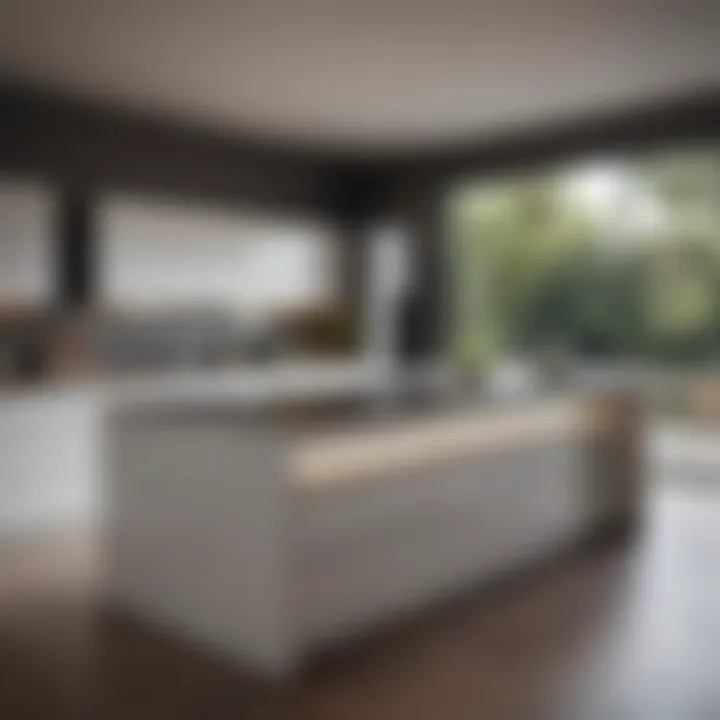
Intro
In modern home design, the kitchen serves as more than just a space for cooking. It is a gathering point, a place for family interaction, and often, the heart of the home. One key element that enhances this experience is the kitchen island. This guide intends to unravel the complex world of kitchen island designs, guiding homeowners and design enthusiasts through critical aspects such as styles, materials, and functions. By exploring these elements, readers can make informed decisions to elevate their kitchens, achieving both beauty and practicality.
Design Inspiration
Trending Styles
Kitchen islands come in a variety of styles, each catering to different preferences. Current trends include:
- Minimalist Designs: Focus on clean lines and functionality, often using materials such as quartz or granite.
- Rustic Charm: Incorporates reclaimed wood or farmhouse sinks for a cozy feel.
- Industrial Appeal: Utilizes metal elements, open shelving, and a raw aesthetic to bring a modern edge.
- Multi-functional Islands: Designed for versatility, providing additional features such as seating areas and built-in appliances.
Each style offers unique advantages, tailoring to the diverse needs of homeowners. It's essential to consider the overall kitchen theme when selecting an island style. For example, a sleek, modern home may benefit from a minimalist island, while a traditional space may be complemented with rustic elements.
Color Palettes
The choice of colors is vital in the design of a kitchen island. Trends indicate a shift towards bold, contrasting colors that add visual interest. Popular choices include:
- Deep Navy or Charcoal: Offers sophistication against lighter cabinetry.
- Soft Pastels: Such as mint green or pale blue for a fresh, airy aesthetic.
- Warm Earth Tones: Keeping in line with the rustic trend, colors like terracotta or beige provide warmth.
When selecting colors, consider the overall design scheme of the kitchen. Colors should harmonize with existing elements to create a cohesive look that appeals to the eye.
Practical Tips
Maintenance & Care
Maintaining a kitchen island depends largely on the materials used. Here are basic care tips:
- Wood: Regularly treat with mineral oil to prevent drying out. Clean spills immediately to avoid stains.
- Granite or Quartz: Use a pH-neutral cleaner to avoid damaging the surface. Seal regularly as per manufacturer's instructions to maintain durability.
- Metal: Clean with non-abrasive cleaners to preserve shine and avoid scratches.
Regular upkeep not only enhances longevity but also keeps the kitchen looking its best.
Budgeting & Planning
Budgeting effectively for a kitchen island is essential. Considerations should include:
- Material Costs: Different materials come with varying price tags.
- Labor: If installation is required, this can increase the cost.
- Additional Features: If planning to incorporate appliances, plumbing, or seating, factor these costs into the budget.
Planning effectively can help homeowners avoid overspending while ensuring the island remains functional and aesthetically pleasing.
A well-considered kitchen island can transform the entire culinary experience, contributing positively to both usability and style.
In summary, choosing the right kitchen island involves understanding design trends, styles, and practical aspects that align with personal tastes and living needs. This guide seeks to provide the necessary insight for making informed decisions, ultimately crafting a kitchen that meets both aesthetic and functional requirements.
Foreword to Kitchen Islands
Kitchen islands have become a staple in modern kitchens, serving multiple purposes that enhance both aesthetics and functionality. Their significance extends beyond mere utility; they play a pivotal role in the overall kitchen layout and design. A well-designed kitchen island can act as a central hub for cooking, dining, and socializing. Due to this, understanding their design and capabilities is crucial for homeowners and design enthusiasts.
One of the main benefits of kitchen islands is their versatility. They can vary widely in size, shape, and style, allowing homeowners to select an option that aligns with their personal taste and the existing kitchen aesthetic. Additionally, they provide extra counter space for cooking and food prep, which can be vital in kitchens where cooking is a key activity. The inclusion of storage compartments in an island also helps in decluttering traditional cabinets, making it easier to maintain an organized kitchen.
Considerations must be taken into account when designing a kitchen island. The layout of the kitchen should dictate the island's placement and design. Furthermore, the potential traffic flow around the island can affect its usability. Choosing the right materials and finishes is important as well, ensuring durability while complementing the overall kitchen theme. Overall, kitchen islands are more than just an addition; they are a functional piece of furniture that can be tailored to enhance the kitchen experience.
Historical Context of Kitchen Islands
The concept of kitchen islands is not a recent innovation. Historically, kitchens were primarily utilitarian spaces, built for functionality rather than comfort or style. The notion of having an island was relatively uncommon. A change occurred in the late 20th century, when open floor plans began to gain popularity. Open-concept layouts allowed for a seamless transition between cooking and social spaces, boosting the demand for kitchen islands.
This shift illustrated the evolving role of the kitchen, moving from a place of solitary cooking to a communal area where families gather. This change in the cultural perception of kitchens significantly influenced the design of kitchen islands.
Current Trends in Kitchen Design
As we move through the 21st century, kitchen design continues to evolve, with islands at the forefront.
Some current trends include:
- Multifunctionality: More homeowners are seeking islands that serve multiple purposes, incorporating features like cooking surfaces, sinks, or even dishwashers into their design.
- Sustainable Materials: There is a noticeable shift towards using environmentally-friendly materials in kitchen designs. Recycled woods and low-VOC finishes are becoming popular choices.
- Bold Designs: There is a growing penchant for islands that make a statement. This includes vibrant colors and unique shapes that stand out.
- Technology Integration: Smart technology is being integrated into kitchen islands, which can include charging stations, built-in speakers, or smart lighting.
These trends reflect a shift towards viewing kitchens as living spaces that reflect personal style while remaining highly functional.
Types of Kitchen Islands
Understanding the different types of kitchen islands is essential for homeowners looking to enhance their kitchen space. Each type serves unique purposes and can substantially affect the overall layout and functionality of a kitchen. Comprehension of these categories allows for informed choices that align with both aesthetic and practical needs. Thus, selecting the right type of kitchen island can optimize space usage, making the kitchen not only a cooking area but also a gathering place.
Fixed Kitchen Islands
Fixed kitchen islands are permanent fixtures in the kitchen layout. These islands are typically larger and often contain essential components such as sinks, stove tops, or substantial storage solutions. The main advantage of a fixed kitchen island is stability and durability. These islands are often designed to match the kitchen cabinetry, providing a seamless flow to the overall design.
When designing a fixed kitchen island, it's important to consider the available space. A well-sized fixed island enables movement around the kitchen without feeling crowded. Fixed islands serve multiple purposes, from food preparation to casual dining. Given their size, they usually become a focal point in kitchen design, enabling hosts to interact with guests while preparing meals.
Mobile Kitchen Islands
Mobile kitchen islands offer flexibility in their use and design. They can be moved as needed, which makes them ideal for smaller spaces. These islands are often equipped with wheels, which allow easy relocation. Homeowners can adjust the layout of their kitchens based on the occasion, which is particularly useful during gatherings.
Another benefit of mobile kitchen islands is their potential for additional storage without permanent commitment. They can house utensils, small appliances, or cookware without occupying valuable floor space permanently. This type of island can adapt based on a homeowner's needs, allowing for enhanced functionality in the kitchen. The appeal of mobile kitchen islands lies in their versatility.
Peninsula Islands
Peninsula islands are a hybrid between fixed kitchens and mobile islands. They are attached to the main kitchen cabinetry but extend out into the kitchen space, resembling a more controlled open area. This type of island functions similarly to a fixed island but generally offers a slightly reduced footprint, making them favorable in compact kitchens.
Peninsulas can serve various purposes as cooking, eating, or preparation areas. The extended top often allows for bar stools or seating, turning it into a social spot in the kitchen without overwhelming the space. These islands can create a defined area for dining or entertaining while maintaining an open-concept feel. Choosing a peninsula island can maximize functionality while keeping the space efficient and inviting.
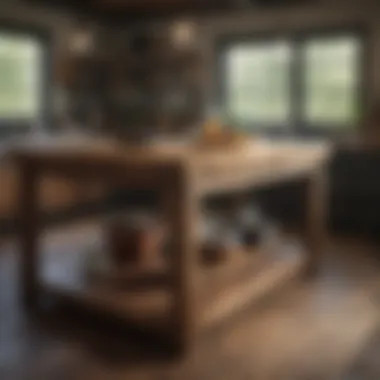
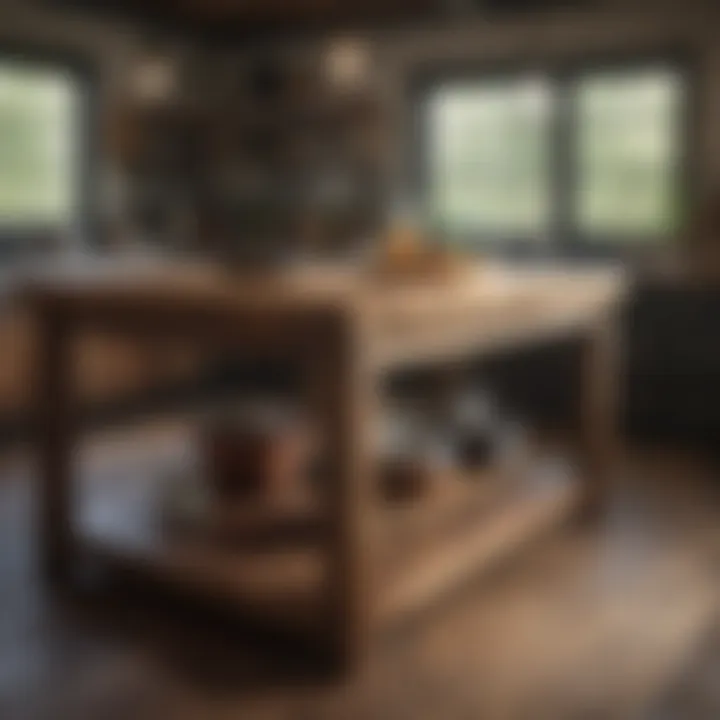
Functionality of Kitchen Islands
The role of kitchen islands extends beyond mere aesthetics; they serve several functional purposes essential to modern living. In contemporary homes, kitchen islands act as a hub of activity, facilitating different tasks from cooking to socializing. When designed effectively, kitchen islands contribute not only to the efficiency of the kitchen but also to its overall atmosphere. Understanding their functionality is crucial in making informed design choices.
Cooking and Preparation Areas
One primary function of a kitchen island is to serve as a cooking and preparation space. It provides additional counter space, making meal preparation more efficient. A well-planned island can include built-in appliances like cooktops or ovens, which allow for an uninterrupted workflow. This setup minimizes the distance one needs to move between food storage, preparation, and cooking areas.
When designing a cooking area, consider the layout carefully. Proper venting is necessary if including a cooktop, while electrical outlets should be conveniently located for small appliances like mixers or food processors. Countertop material should also be durable, as kitchens endure high traffic and potential spill incidents. Materials such as quartz or granite are practical choices for a busy cooking environment.
Dining and Social Space
Kitchens today serve as social spaces where families gather and entertain guests. A kitchen island can double as a casual dining area. Bar stools or counter-height chairs offer a relaxed seating option that encourages interaction. This makes the island not just a workspace but also a gathering point for conversations during meal preparation or serving.
To enhance the dining experience, consider the placement of the island. It should facilitate a good flow of movement while ensuring that those seated have a clear view of the main kitchen area or the dining space. Adding features such as built-in wine racks or small refrigerators can enrich the functionality, turning the island into a complete entertainment center.
Storage Solutions
Incorporating effective storage in a kitchen island is vital. Islands can provide extra cabinetry, which is beneficial in maximizing the use of space. Deep drawers can house pots and pans, while shelves can be used for cookbooks or decorative items. Open shelving can also be visually appealing, allowing for a display of attractive kitchenware while keeping essential items accessible.
Consider customizing storage to specific needs. Pull-out shelves can simplify access to smaller items, while trash pull-outs can conceal waste bins, maintaining a clean and organized appearance. Proper storage solutions in the island can keep kitchen clutter at bay, leading to a more functional cooking space.
Multifunctional Uses
The versatility of kitchen islands allows them to serve multifaceted roles in the home. Beyond cooking and dining, they can be transformed for various activities such as homework stations, craft areas, or even home office spaces. The key is to tailor the island's design to meet diverse needs.
For instance, incorporating a power outlet can support laptops or charging devices, making it perfect for a study area. Alternatively, installing pull-out tables or expandable surfaces can create more room when needed, then retract for a streamlined look when not in use. This flexibility is vital in optimizing space, especially in homes with limited square footage.
"Kitchen islands are more than just a culinary workspace; they are the heart of social gatherings and multifunctional areas in modern homes."
In summary, understanding the functionality of kitchen islands is essential for homeowners and design enthusiasts alike. Each aspect—cooking, dining, storage, and multifunctionality—plays a crucial role in enhancing the overall kitchen experience. Properly designed kitchen islands not only improve daily tasks but also elevate the kitchen's social environment.
Design Styles for Kitchen Islands
Understanding the various design styles for kitchen islands is crucial. It goes beyond mere aesthetics; the chosen style reflects personal taste and complements the overall kitchen theme. Emphasizing coherence in design means that homeowners can create spaces that are both functional and visually harmonious.
A key benefit of selecting an appropriate design style is that it can significantly enhance the kitchen's usability. A kitchen island can act as a statement piece that binds together diverse elements, contributing to an inviting atmosphere. Whether one prefers a modern touch or a more traditional feel, knowing the nuances of each style helps make informed decisions that align with practical needs.
Modern and Minimalist Designs
Modern and minimalist designs focus on simplicity and functionality. These styles often involve clean lines, muted colors, and less clutter. The minimalist kitchen island typically features a sleek countertop, such as quartz, that pairs well with smooth cabinetry, often in monochromatic shades.
Key elements of this style include:
- Functional Surfaces: The emphasis is on practicality, where the island serves various roles, including cooking, eating, or working without unnecessary embellishments.
- Integrated Technology: Many modern islands incorporate tech solutions like built-in charging stations or induction cooktops. This integration enhances workflow and reduces visual clutter.
Adopting modern minimalism cultivates a peaceful environment in the kitchen, making it easier to navigate and work efficiently.
Rustic and Farmhouse Aesthetics
Rustic and farmhouse kitchen islands provide a warm and welcoming feel. Characterized by the use of natural materials and traditional craftsmanship, they evoke a sense of comfort and familiarity.
Common features include:
- Reclaimed Wood: Often, these islands feature surfaces made from reclaimed wood, which adds character and tells a story.
- Subtle Colors: Earthy tones like soft whites, browns, and greens are prevalent, promoting a relaxed ambiance.
The rustic style is ideal for those looking to bring charm and personality into their kitchen. It combines functionality with a cozy aesthetic, encouraging gatherings and family interaction.
Industrial Style Islands
Industrial style kitchens are marked by raw materials and a rugged, unfinished look. This design often suits urban settings or open spaces.
Characteristics of industrial kitchen islands include:
- Metal Elements: Stainless steel, iron, or copper elements can create bold contrasts against wooden surfaces.
- Exposed Features: Visible pipes, beams, and brick can enhance the industrial vibe.
An industrial kitchen island serves not only as a meal prep space but also as a conversation piece, reflecting modernity without sacrificing utility.
Traditional and Classic Options
Traditional kitchen islands embody timeless elegance and intricate designs. Older styles often include ornate details and rich color tones.
Key traits are:
- Rich Wood Finishes: Dark woods such as mahogany or walnut bring sophistication and warmth.
- Detailed Ornamentation: Custom features like decorative moldings can add depth and interest.
For homeowners favoring classic aesthetics, these islands deliver both beauty and functionality, seamlessly fitting in with heritage themes while providing ample workspace for various tasks.
Materials Used in Kitchen Islands
When considering kitchen islands, the choice of materials is a crucial aspect that directly affects both aesthetics and functionality. The materials used can enhance durability, ease of maintenance, and the overall design of the kitchen. Selecting the right material also involves considering the cooking habits, style preferences, and how the island will be utilized. Moreover, different materials can influence the atmosphere of the kitchen, making this an essential factor in any kitchen remodeling effort.
Wood and Its Variants
Wood is a timeless choice for kitchen islands, often associated with warmth and natural beauty. Its adaptability to various styles makes it quite popular. Common wood types for kitchen islands include maple, oak, and cherry. Each variety offers unique qualities:
- Maple is known for its hardness and durability, making it suitable for high-traffic areas.
- Oak offers a classic look and tends to resist warping.
- Cherry has a rich color that deepens over time, providing a sophisticated finish.
While wood islands can present challenges, such as susceptibility to scratches and moisture damage, proper sealing and regular maintenance minimize these issues. Enhancements like staining or painting can create different aesthetics, allowing wood to align with the kitchen's design direction.
Stone Countertops
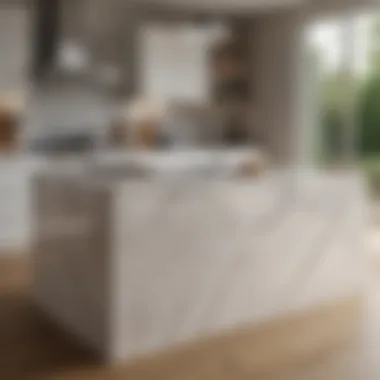
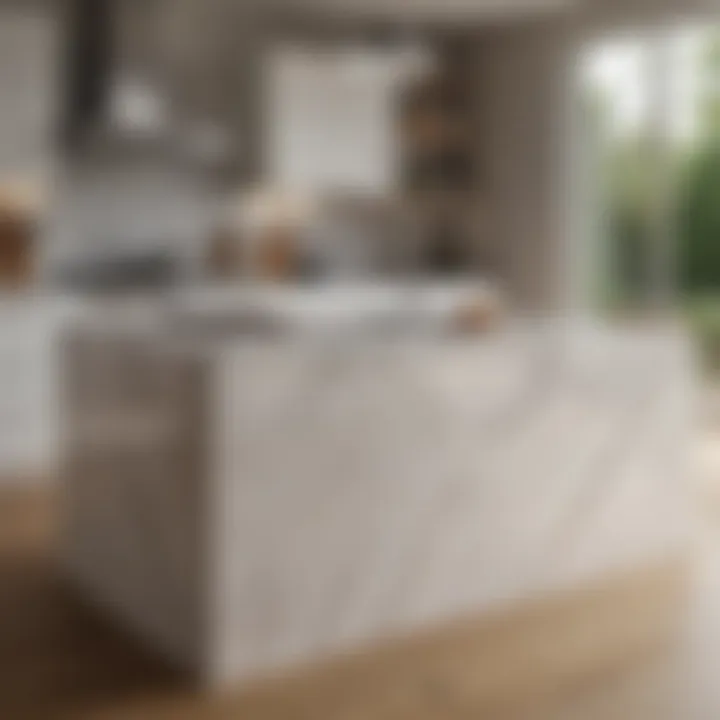
Stone countertops, such as granite and quartz, add a robust and elegant feel to kitchen islands. Granite is often favored for its unique patterns and heat resistance, making it ideal for cooking. Homeowners appreciate that granite can outperform many other materials in terms of durability; however, it requires periodic sealing to prevent stains.
On the other hand, quartz offers uniformity and a non-porous surface, making it easier to maintain. It's engineered to include resins which add to its strength and resistance against chips. Choosing stone countertops enhances the overall kitchen experience by providing both style and practicality.
Metal Finishes
Metal finishes are a modern option that can bring an industrial edge to kitchen designs. Stainless steel, brass, and copper are notable materials utilized for their modern appeal and practicality. Stainless steel is favored for its resistance to heat and stains, ensuring longevity in performance. It is easy to clean, making it suitable for a busy kitchen environment.
Brass and copper can add elegance but require careful maintenance to prevent tarnishing. Protective coats can help keep these metals looking fresh. When used properly, metal finishes can create a striking contrast against wood or stone, enhancing the visual appeal of the kitchen island.
Composite and Engineered Materials
Composite and engineered materials like solid surface and laminate are ideal for homeowners seeking cost-effective yet stylish options. Solid surfaces, such as Corian, provide seamless designs and are resistant to stains and scratches. They can mimic the appearance of natural stone without the high maintenance needs.
Laminate is another budget-friendly option, available in a wide range of colors and textures. This material can replicate the look of wood or stone but lacks the same level of durability. However, both options provide ease of installation, making them attractive to those looking to save time and expense during renovations.
In summary, the choice of material for a kitchen island is significant in various aspects, from functionality to design. By understanding the characteristics and benefits of each material, homeowners can make informed decisions that enhance their kitchen's beauty and usability.
Incorporating Kitchen Islands in Different Layouts
The role of kitchen islands is evolving as kitchens become the heart of homes. Understanding how to effectively incorporate kitchen islands in various layouts provides both functionality and aesthetic appeal. A well-placed island can facilitate movement, enhance workspace, and serve as a gathering point for family and friends, promoting a sense of community in the home.
Each kitchen layout may require different design approaches to maximize the benefits of an island. This influences not just space usage but also the overall experience of the kitchen. Here, we will examine the specific layouts—open-concept, galley, and L-shaped—and discuss how kitchen islands can be optimally integrated into each.
Open-Concept Layouts
Open-concept kitchens prioritize space and flexibility. This layout merges the kitchen with adjacent living areas, creating flow and openness. Incorporating a kitchen island in such an arrangement provides a seamless transition between spaces.
- Functional Workstations: The island can become a central area for food preparation while still keeping the cook connected with family or guests.
- Socializing Space: With bar stools or high chairs, the island can transform into an informal dining area, perfect for casual meals and discussions.
- Visual Appeal: A well-designed island can serve as a focal point, complementing the overall decor of the combined spaces.
Galley Kitchens
Galley kitchens, characterized by two parallel counters, offer a more compact cooking environment. In these settings, a kitchen island must be efficiently planned to maintain the space's functionality.
- Efficient Use of Space: If space allows, a narrow island can be integrated to offer additional prep area without disrupting the kitchen's workflow.
- Storage Solutions: Utilize drawer space or shelving under the island to store cookware or utensils, optimizing every inch of space in a galley design.
- Task Area: The island can serve as a dedicated cooking zone, separating tasks between the two sides of the galley, increasing efficiency.
L-Shaped Kitchens
In L-shaped kitchens, an island adds depth and functionality to an already practical layout. This design offers more openness compared to galley kitchens while maintaining delineation between areas.
- Connection Point: The island can connect the two segments of the L, improving workflow and accessibility across the kitchen areas.
- Multi-Functionality: This layout allows for an island to act as a cooking center, dining space, or even a homework hub for children.
- Design Cohesion: Choosing materials and finishes that match or complement the existing cabinetry can create a harmonized look, enhancing the visual appeal of your L-shaped kitchen.
In summary, incorporating kitchen islands into various layouts not only enhances the kitchen's function but also elevates its design. Consideration of space, usability, and aesthetics will lead to a well-integrated kitchen that serves its purpose effectively.
Lighting Considerations for Kitchen Islands
Lighting is a crucial aspect of kitchen design, particularly when it comes to islands. Proper illumination not only enhances the aesthetic appeal but also increases functionality. Kitchen islands often serve as the central workspace, dining area, and social hub in modern kitchens. Thus, thoughtful lighting design can significantly elevate the overall experience in this often-busy space.
Choosing the right lighting can create a warm and inviting atmosphere, while also ensuring adequate brightness for tasks like cooking and food preparation. Factors such as the style of the kitchen, the height of the island, and the placement of fixtures all play a role in effective lighting design. It's important to integrate various types of lighting to cater to different needs at different times of the day.
Pendant Lighting Options
Pendant lights are often the go-to choice for illuminating kitchen islands. They hang from the ceiling and can provide focused lighting right where it is needed. When selecting pendant lights, consider the following:
- Size and Scale: The dimensions of the pendants should be proportional to the kitchen island size. Large islands may require multiple pendants for balanced illumination.
- Style Harmony: Choose pendant lights that complement the overall kitchen style, whether it is modern, rustic, or industrial.
- Bulb Type: The type of bulbs used in pendant lighting, such as LED or incandescent, can affect both the brightness and ambiance.
A well-placed row of pendant lights can create a focal point and enhance the design of the kitchen.
Recessed Lighting Techniques
Recessed lighting, or can lights, is another effective option for kitchen islands. These lights are installed flush with the ceiling, offering a clean and unobtrusive look. Here are some strategies for using recessed lighting:
- Layering Light: Combine recessed lights with other forms of lighting. This offers flexibility to illuminate the island effectively.
- Spacing Considerations: Ensure proper spacing between recessed fixtures to avoid shadows. A general rule is to place the lights about 4-6 feet apart.
- Dimming Options: Installing dimmers can offer control over the light intensity, allowing for adjustments according to the time of day or activity.
Recessed lighting can streamline the look of the kitchen while providing adequate light across the area.
Task and Ambient Lighting Balance
Achieving a good balance between task and ambient lighting is essential for a well-lit kitchen island. Task lighting is focused and meant for specific activities, while ambient lighting provides overall illumination. Here are key points to consider:
- Mix Light Sources: Use a combination of task lights, such as pendants or under-cabinet lighting, with ambient lights to ensure that the entire space is well lit.
- Avoid Harsh Glares: Install fixtures in a way that prevents glare on work surfaces while still providing ample light.
- Lighting Zones: Create different lighting zones for various kitchen functions. For example, brighter light for cooking and softer ambient light for dining.
It is pivotal to blend these lighting types to foster a versatile environment for both efficiency and relaxation.
"Proper lighting in a kitchen is as crucial as the layout itself; it can either enhance or diminish the functionality of the space."
Color Schemes and Finishes
Color schemes and finishes play a crucial role in establishing the overall aesthetic of kitchen islands. These elements not only influence the island's visual appeal but also affect the mood and functionality of the kitchen space. Choosing the right colors can create harmony or contrast, making the island a focal point in the room. Additionally, finishes can add texture and depth, enhancing both the beauty and durability of the materials used. It is essential to consider these aspects carefully to ensure that the kitchen island complements the existing decor and meets the homeowner's practical needs.
Neutral Color Palettes
Neutral colors serve as a versatile backdrop and are widely appreciated for their ability to blend with various styles. Shades like white, beige, gray, and taupe can impart a sense of calm and openness to the kitchen. They allow for greater flexibility in design choices, giving homeowners the freedom to incorporate accessories, such as colorful kitchenware or vibrant artwork, without clashing.
Using neutral colors can also create an illusion of space, especially in smaller kitchens. They reflect light better, making the area feel larger and more inviting. Homeowners might opt for a soft white island paired with darker cabinets to create a striking yet balanced appearance.
On the other hand, accents of warmth, such as wood finishes or brass hardware, can further enrich the neutral palette and add depth without overwhelming the space.
Bold and Vibrant Options
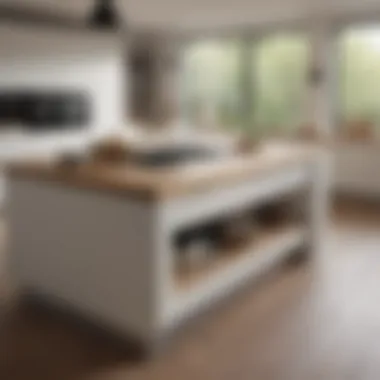
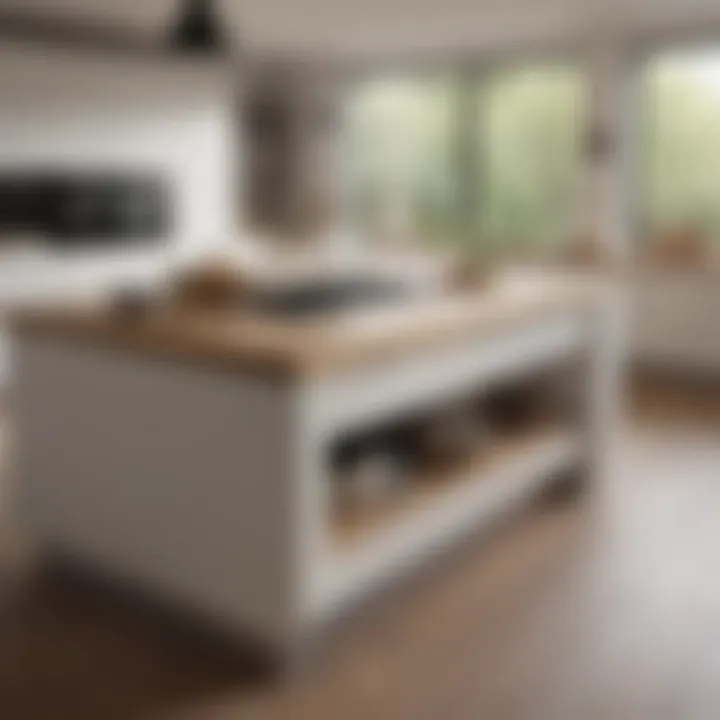
For those looking to make a statement, bold and vibrant colors can transform a kitchen island into a dramatic centerpiece. Colors like deep blue, rich green, or even bright red can inject personality and energy into the space. These shades can evoke specific emotions and create a lively atmosphere, ideal for dining or socializing.
However, it is important to approach vibrant colors thoughtfully. Consider using them as an accent against more subdued cabinetry or walls to maintain balance. When choosing bold colors, the right finish matters as well. A matte finish might soften the impact, while a glossy finish can enhance brightness and reflectivity.
Matte vs. Gloss Finishes
The choice between matte and gloss finishes affects both the appearance and practicality of a kitchen island.
Matte finishes present a subtle, understated look that conveys modernity. They are less prone to showing fingerprints and smudges, making them a good choice for high-traffic areas. This type of finish can lend itself well to neutral or bold colors alike, creating a sophisticated vibe.
Gloss finishes, by contrast, are reflective and can make spaces feel brighter and more open. They can add a touch of elegance, particularly when used with darker shades. However, gloss finishes may require more maintenance, as they can show dirt and grease more easily.
Sustainable Practices in Kitchen Island Design
In the contemporary era, sustainability has transcended mere ideology, becoming a necessity in design, particularly in home spaces. The kitchen, often regarded as the heart of the home, is no exception. Sustainable practices in kitchen island design not only focus on the materials used but also the overall life cycle of the island, from its production to its disposal. Embrace sustainable practices can lead to benefits such as reduced environmental impact, improved air quality, and long-term cost savings.
Use of Recycled Materials
The integration of recycled materials in kitchen island construction is a significant sustainable practice. This includes repurposed wood, reclaimed stone, and recycled metals. By opting for these materials, homeowners can dramatically lower their carbon footprint. Recycled materials often possess unique characteristics that contribute to the aesthetic appeal of the kitchen. Creating a kitchen island from such materials may also support local suppliers or artisans, fostering community relationships.
Key considerations include checking the source and maintenance requirements of recycled materials. It is important to ensure that the materials are durable and suitable for kitchen use. Ultimately, using recycled materials aligns with eco-conscious living and demonstrates an awareness of environmental preservation.
Eco-friendly Finishes
Finishes play a crucial role in the sustainability of kitchen islands. Eco-friendly finishes include non-toxic paints, varnishes, and stains made from natural ingredients. These options drastically reduce volatile organic compounds (VOCs), which can pollute indoor air quality and harm health.
In addition to health benefits, eco-friendly finishes often maintain the integrity of the materials beneath while enhancing their appearance. Some examples include plant-based oils and water-based paints. Homeowners should prioritize products with certifications such as Green Seal and Cradle to Cradle. These certifications indicate a commitment to sustainable practices and environmentally responsible production.
Energy-efficient Lighting Solutions
Lighting is a fundamental part of kitchen island design, and it can also be approached through a sustainable lens. Energy-efficient lighting solutions, such as LED fixtures, drastically reduce electricity consumption compared to traditional incandescent bulbs. Moreover, LEDs have a longer lifespan, which means less frequent replacements and reduced waste.
Consideration should also be given to the placement of lighting. Using natural light during the day reduces the need for artificial lighting and creates a pleasant ambiance. Additional features, such as dimmers or timers, enhance energy efficiency by allowing users to control their lighting based on need.
"Utilizing energy-efficient lighting not only reduces costs but also contributes to a more sustainable kitchen environment."
Budgeting for a Kitchen Island
When planning for a kitchen island, budgeting plays a crucial role. A thoughtful budget influences every aspect of the design and construction process, ensuring that the final product meets both aesthetic desires and practical needs. Being realistic about costs can help homeowners avoid overspending and guide them in making informed decisions regarding materials, size, and additional features.
Establishing a budget for a kitchen island encompasses various specific elements, including materials, labor, and appliances. Each of these factors contributes to the overall expenditure and should be evaluated carefully to maintain a balanced budget. In addition to direct costs, one should consider potential future expenses, like maintenance or modifications, to ensure long-term satisfaction with the kitchen island.
Benefits of Budgeting:
- Cost Management: It helps in tracking expenses and avoiding financial strain.
- Prioritization: Budgeting encourages homeowners to prioritize. By understanding their financial limits, they can choose essential features over lavish add-ons.
- Efficiency: A well-structured budget promotes efficient use of resources, minimizing waste and maximizing value.
Cost Factors to Consider
Several cost factors come into play when budgeting for a kitchen island. Understanding these components allows for better financial planning. Some of the main considerations include:
- Materials: The choice of materials significantly impacts the cost. Hardwoods like cherry or oak may be more expensive compared to laminate finishes.
- Size and Design Complexity: Larger islands with intricate designs will naturally require more materials and labor, affecting the overall cost.
- Appliances: If including appliances like refrigerators or wine coolers, factor in the corresponding prices, which can add to budget constraints.
- Installation: Professional installation might be necessary depending on the complexity of the project, which increases labor costs.
"Comprehensive budgeting ensures that aspirations for a beautiful kitchen island are matched with financial reality."
DIY vs. Professional Installation
The decision on installation methods can also affect the budgeting process. Homeowners often face the choice between DIY projects and hiring professionals. Each option comes with its own set of benefits and challenges.
DIY Installation:
- Often a more economical choice, reducing labor costs.
- Allows for personal customization, as homeowners can tailor the island to their specifications.
- However, it can lead to unexpected challenges that may increase costs if mistakes occur.
Professional Installation:
- While generally more expensive due to labor charges, expert installation may ensure a polished finish and structural integrity.
- Professionals can also provide valuable insights based on their experience, helping to prevent costly errors.
- Some homeowners might consider financing options for professional services, which can help manage cash flow.
Ultimately, the decision between DIY and professional installation should align with one's budget, skill level, and desired outcomes.
Maintaining Your Kitchen Island
Maintaining your kitchen island is essential for ensuring its longevity and preserving its aesthetic appeal. Kitchen islands often serve as the focal point of a kitchen, providing not only functionality but also enhancing the overall design. Regular maintenance helps prevent wear and tear, reducing the need for costly repairs or replacements.
One significant aspect of maintenance is the impact it has on hygiene. Kitchen islands are commonly used for food preparation and dining. Keeping surfaces clean is vital to avoid cross-contamination and maintain a healthy environment. Additionally, regular upkeep can enhance the visual appeal of your kitchen, ensuring that the island remains an inviting space for family and guests.
Daily Maintenance Tips
- Clean the Surface: Use a gentle cleaner suitable for your island's material. For wood, use a damp cloth. For stone, a mild detergent with water is best. Always dry it afterward to prevent water damage.
- Check for Spills Immediately: Wipe any spills right away. This practice prevents stains and sticky residues which can affect both appearance and hygiene.
- Organize Items: Keep the island tidy. Regularly remove any items that do not belong on the surface. An organized space not only looks better but is also more functional.
- Inspect for Damage: Each day, take a moment to check for scratches, dents, or other signs of wear. Addressing these issues early can prevent further damage.
- Sanitize: Especially if the island is used for food prep, sanitize surfaces regularly to limit bacteria and germs.
Annual Upkeep Considerations
- Deep Cleaning: Once a year, perform a thorough cleaning. This involves wiping down the entire island, focusing on areas that are often neglected, such as undersides and corners.
- Refinish Wood Surfaces: If your kitchen island is made of wood, consider refinishing it every few years to maintain its luster and durability. This can involve sanding and applying a new coat of finish.
- Check Connections and Fixtures: If your island includes electrical outlets or plumbing, inspect these connections yearly. Look for signs of wear or malfunction to prevent potential hazards.
- Evaluate Storage: Assess how well the storage areas in and around your island are functioning. Decluttering and reorganizing can improve accessibility and usability.
- Plan for Upgrades: Each year, think about possible upgrades. This might include replacing hardware or potentially redesigning layout factors to increase efficiency and aesthetics.
Maintaining your kitchen island is not just about cleanliness; it's also about preserving the beauty and functionality of one of your home's most versatile furnishings.
In summary, maintaining your kitchen island involves a blend of daily care and annual deep cleaning tasks that ensure your investment remains valuable over time.
Epilogue
The conclusion of this article serves as a pivotal reflection on the multifaceted nature of kitchen island designs. It emphasizes the importance of understanding how these vital components enhance both functionality and style in modern kitchens. A well-designed kitchen island is not just a surface for preparation; it becomes a central element of family life, serving various purposes from cooking to socializing.
Future Trends in Kitchen Island Design
As we look to the future, several trends are shaping the design of kitchen islands. Homeowners and designers are increasingly prioritizing versatility and sustainability. Here are some key trends:
- Sustainable Materials: The use of recycled or eco-friendly materials is gaining traction. This reflects a broader societal shift toward environmental consciousness. Consumers are looking for options that reduce their carbon footprint.
- Smart Technology: Integration of smart devices into kitchen islands is becoming more common. Homeowners are eager to incorporate features like built-in charging stations, touchless faucets, or even smart appliances to improve everyday efficiency.
- Bold Design Choices: In contrast to previous trends emphasizing minimalism, more homeowners are embracing bold colors and unique shapes for their islands. This trend helps the island stand out, becoming a statement piece within the kitchen.
- Multi-Functional Spaces: The trend of making kitchen islands more than just a workspace continues to grow. People are designing islands that accommodate dining, working, or even relaxing. Barstools or built-in seating arrangements enhance this functionality.
- Personalization: Customization is a significant trend, allowing homeowners to tailor their kitchen islands to fit their specific needs and tastes. This can include unique finishes, built-in storage solutions, or personalized dimensions that suit the kitchen's layout.
As kitchen island trends continue to evolve, they adapt to the changing needs of homeowners and technological advancements.















